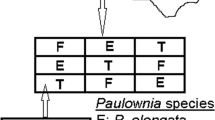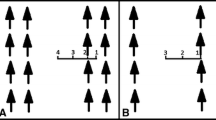Abstract
Intra-annual growth rates were assessed during 3 years for four Populus clones grown in pure and mixed clonal stands at square spacings of 0.5, 1.0 and 1.5 m in western Washington, USA. Height growth rate peaked in August, except at the 0.5-m spacing where it peaked in July and June in years 2 and 3, respectively. Diameter growth rate generally peaked in June. Seasonal growth patterns in mixed clonal stands, relative to those in pure clonal stands, varied by clone. Following early season moisture stress in year 2, growth of a P. balsamifera ssp. trichocarpa clone declined significantly relative to three P. balsamifera ssp. trichocarpa × P. deltoides clones; this trend was most evident at the 0.5-m spacing. During this period of moisture stress, P. balsamifera ssp. trichocarpa had 11 and 36% mortality in pure and mixed stands, respectively, at the 0.5-m spacing; this clone had no mortality at wider spacings during the same period. Although height rankings among clones shifted during the first growing season, rankings at the end of year 1 were very similar to those at the end of year 3.





Similar content being viewed by others
References
Benbrahim M, Gavaland A, Gauvin J (2000) Growth and yield of mixed polyclonal stands of Populus in short-rotation coppice. Scan J For Res 15:605–610
Brodie LC, DeBell DS (2004) Evaluation of field performance of poplar clones using selected competition indices. New For 27:201–214
Ceulemans R, Impens I, Imler R (1988) Stomatal conductance and stomatal behavior in Populus clones and hybrids. Can J Bot 66:1404–1414
Ceulemans R, Stettler RF, Hinckley TM, Isebrands JG, Heilman PE (1990) Crown architecture of Populus clones as determined by branch orientation and branch characteristics. Tree Phys 7:157–167
Ceulemans R, Scarascia-Mugnozza G, Wiard BM, Braatne JH, Hinckley TM, Stettler RF (1992) Production physiology and morphology of Populus species and their hybrids grown under short rotation. I. Clonal comparisons of 4-year growth and phenology. Can J For Res 22:1937–1948
DeBell DS, Harrington CA (1993) Deploying genotypes in short-rotation plantations: mixtures and pure cultures of clones and species. For Chron 69:705–713
DeBell DS, Harrington CA (1997) Productivity of Populus in monoclonal and polyclonal blocks at three spacings. Can J For Res 27:978–985
Foster GS, Rousseau RJ, Nance WL (1998) Eastern cottonwood clonal mixing study: intergenotypic competition effects. For Ecol Manage 112:9–22
Hinckley TM, Ceulemans R, Dunlap JM, Figliola A, Heilman PE, Isebrands JG, Scarascia-Mugnozza G, Schulte PJ, Smit B, Stettler RF, van Volkenburgh E, Wiard BM (1989) Physiological, morphological and anatomical components of hybrid vigor in Populus. In: Kreeb KH, Richter H, Hinckley TM (eds) Structural and functional responses to environmental stresses. SPB Academic Publishing bv, The Hague, pp 199–217
Hinckley TM, Braatne J, Ceulemans R, Clum P, Dunlap J, Newman D, Smit B, Scarascia-Mugnozza G, van Volkenburgh E (1992) Growth dynamics and canopy structure. In: Mitchell CP, Ford-Robertson JB, Hinckley TM, Sennerby-Forsse L (eds) Ecophysiology of short rotation forest crops. Elsevier Applied Science, London, pp 1–33
Jonsson TH, Óskarsson Ú (2007) Shoot growth strategy of 29 black cottonwood (Populus trichocarpa) clones. Icelandic Agric Sci 20:25–36
Kraft G (1884) Beiträge zur Lehre von den Durchforstungen. Schlagstellungen und Lichtungshieben, Klingworth
Lindgren D (1993) The population biology of clonal deployment. In: Ahuja MR, Libby WJ (eds) Clonal forestry. I. Genetics and biotechnology. Springer, Berlin, pp 34–49
McCracken AR, Dawson WM, Carlisle D (2005) Short rotation coppice willow mixtures and rust disease development. In: Pei MH, McCracken AR (eds) Rust diseases of willow and poplar. CABI Publishing, Wallingford, pp 185–194
Minckler LS, Woerheide JD (1968) Weekly height growth of cottonwood. For Sci 14:212–216
Miot S, Frey P, Pinon J (1999) Varietal mixture of poplar clones: effects on infection by Melampsora larici-populina and on plant growth. Eur J For Path 29:411–423
Pregitzer KS, Hendrick RL, Fogel R (1993) The demography of fine roots in response to patches of water and nitrogen. New Phytol 125:575–580
SAS Institute (2005) The SAS system for windows. Version 9.1. SAS Institute Inc., Cary, NC
Scarascia-Mugnozza GE, Isebrands JG, Hinckley TM, Stettler RF (1989) Dynamics of light interception, lead area and biomass production in Populus clones in the establishment year. Ann For Sci 46(suppl):515s–518s
Scarascia-Mugnozza GE, Hinckley TM, Stettler RF, Heilman PE, Isebrands JG (1999) Production physiology and morphology of Populus species and their hybrids grown under short rotation. III. Seasonal carbon allocation patterns from branches. Can J For Res 29:1419–1432
Sennerby-Forsse L (1995) Growth processes. Biomass Bioenergy 9:35–43
Stelzer HE (1997) Evaluating genetic diversity concerns in clonal deployments. Can J For Res 27:438–441
Stettler RF, Bradshaw HD, Zsuffa L (1992) The role of genetic improvement in short rotation forestry. In: Mitchell CP, Ford-Robertson JB, Hinckley T, Sennerby-Forsse L (eds) Ecophysiology of short rotation forest crops. Elsevier Applied Science, London, pp 284–308
Tauer CG (1975) Competition between selected black cottonwood genotypes. Silvae Genetica 24:44–49
Verwijst T (1990) Clonal differences in the structure of a mixed stand of Salix viminalis in response to Melampsora and frost. Can J For Res 20:602–605
Willebrand E, Verwijst T (1993) Population dynamics of willow coppice systems and their implications for management of short-rotation forests. For Chron 69:699–704
Zar JH (1999) Biostatistical analysis. Prentice Hall, Upper Saddle River 663 pp
Acknowledgments
This study was funded by the Short Rotation Woody Crops Program of the U.S. Department of Energy through Interagency Agreement No. DE-A105-810R20914. We thank the Washington State Department of Natural Resources for providing the study site.
Author information
Authors and Affiliations
Corresponding author
Additional information
D. S. DeBell is now retired.
Rights and permissions
About this article
Cite this article
Devine, W.D., Harrington, C.A. & DeBell, D.S. Intra-annual growth and mortality of four Populus clones in pure and mixed plantings. New Forests 39, 287–299 (2010). https://doi.org/10.1007/s11056-009-9171-6
Received:
Accepted:
Published:
Issue Date:
DOI: https://doi.org/10.1007/s11056-009-9171-6




